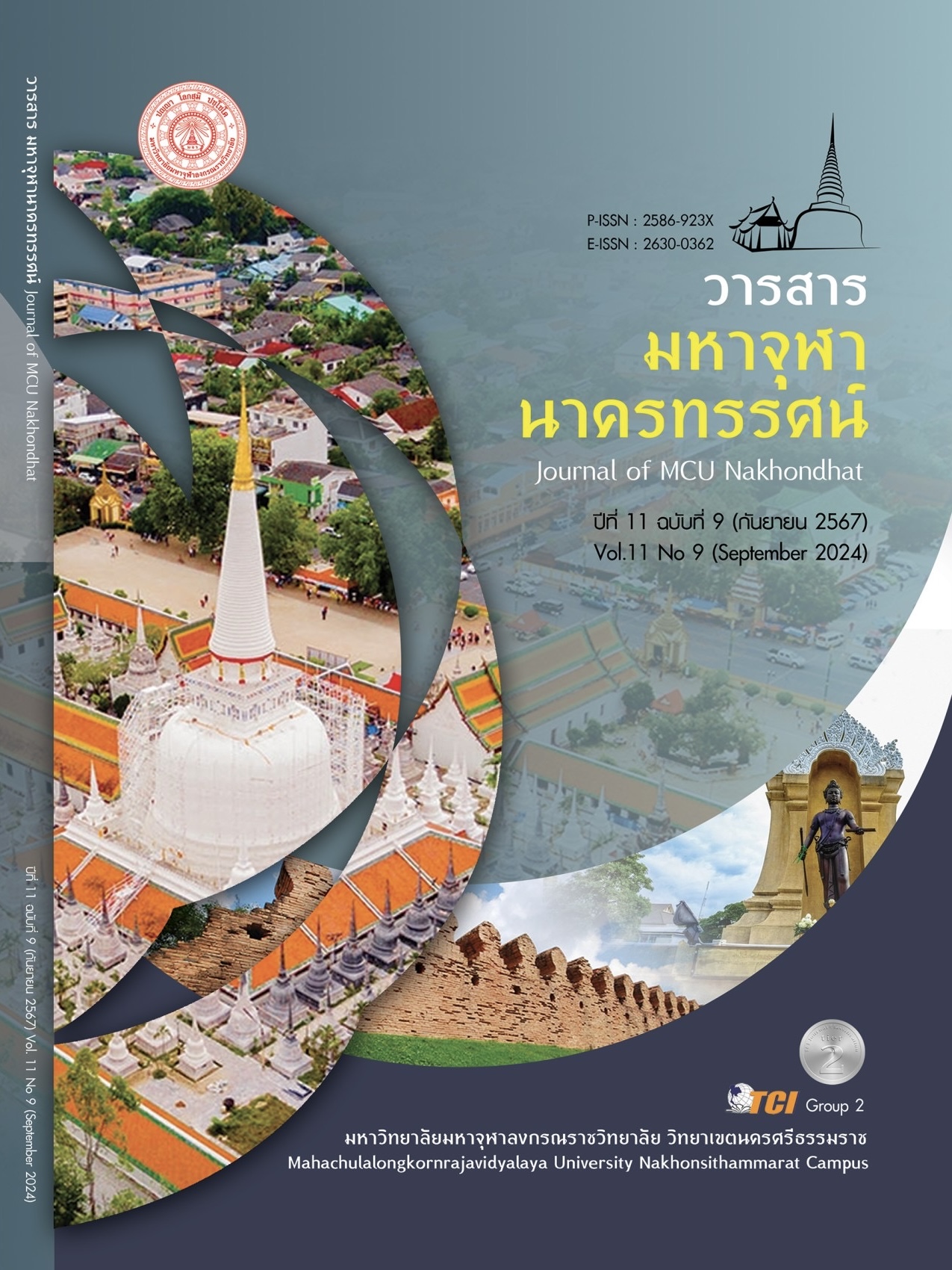AN APPLICATION OF 4 SANGAHAVATTHU PRINICPLES IN LIVING OF LAMPAM COMMUNITY, LAMPAM SUBDISTRICT, MUANG DISTRICT, PHATTHALUNG PROVINCE
Main Article Content
Abstract
The objectives of this research paper are to The objectives of the study were 1) Study the concept of the living of the Ban Lampam communit, Lampam subdistrict, Mueang district, Phatthalung province; 2) Investigate 4 Sangahavatthu principles in the Theravada Buddhist scriptures; 3) Apply the 4 Sangahavatthu principles in the living of the Ban Lampam communit, Lampam subdistrict, Mueang district, Phatthalung province. This is a qualitative research study. The researcher will collect data through in-depth interviews with five monks, five community committee members, and ten residents, totaling 20 participants. The data collected will be analyzed, summarized, and presented in a descriptive narrative format. The results of the study showed that: 1) Living refers to the coexistence of people in society. Currently, the Ban Lampam community faces issues such as a lack of morality, generosity, and mutual assistance. Inappropriate behavior within the community is causing various problems. 2) The 4 Sangahavatthu principles are ethical guidelines that help harmonize people in a community to live together happily. They should be applied in daily life to promote development and improvement by disseminating and sharing them so that everyone in the community follows them. 3) The application of the 4 Sangahavatthu principles, by Applying the four principles of 4 Sangahavatthu to address livelihood issues in the Ban Lam Pam community, Lam Pam Subdistrict, Mueang District, Phatthalung Province includes. 1) The principle of Dana refers to giving or sacrificing possessions for the benefit of others. It addresses issues of self-sacrifice within the community by encouraging detachment from attachment and fostering generosity. 2) The principle of Piyavacha involves using kind and polite speech. It helps build good relationships and reduce conflicts by promoting respectful communication. 3) The principle of Atthacariya promotes selfless service for the common good, reduces selfishness, and fosters unity. 4) The principle of Samanattata fosters consistency in behavior, reduces inequality, and promotes trust within the community.
Article Details

This work is licensed under a Creative Commons Attribution-NonCommercial-NoDerivatives 4.0 International License.
References
ดำรงศักดิ์ แก้วเพ็ง. (2556). ชุมชน. สงขลา: นำศิลป์โฆษณา.
ประเวศ วะสี. (2541). ประชาคมตำบล. กรุงเทพมหานคร: มติชน.
ประเวศ อินทองปาน และคณะ. (2559). “การนำหลักสังคหวัตถุ 4 ไปใช้ในการดำเนินชีวิตประจำวัน”. วารสารมหาจุฬานาครทรรศน์, 3(2), 30-31.
ปราสาท หลักศิลา. (2514). ชุมนุมชน. กรุงเทพมหานคร: สภาวิจัยแห่งชาติ.
พระเดชา กิตฺติโก (โชติธราธรรม). (2556). การบริหารงานบุคคลตามหลักสังคหวัตถุ 4 ของผู้บริหารโรงเรียนธรรมภิรักษ์เขตบางพลัด กรุงเทพมหานคร. ใน วิทยานิพนธ์พุทธศาสตรมหาบัณฑิต สาขาวิชาการบริหารการศึกษา. มหาวิทยาลัยมหาจุฬาลงกรณราชวิทยาลัย.
พระพรหมคุณาภรณ์ (ป.อ.ปยุตฺโต). (2550). ธรรมนูญชีวิต. (พิมพ์ครั้งที่ 82). กรุงเทพมหานคร: บริษัท พิมพ์สวย จำกัด.
พระสุนทร ธมฺมวโร (บญุคง). (2561). การประยุกต์ใช้หลักสังคหวัตถุ 4 ในชุมชนวัดหนองสนม จังหวัดระยอง. ใน วิทยานิพนธ์พุทธศาสตรมหาบัณฑิต สาขาวิชาพระพุทธศาสนา. มหาวิทยาลัยมหาจุฬาลงกรณราชวิทยาลัย.
พระโสภณ โสภโณ (ทองสม). (2563). การประยุกต์ใช้หลักสังคหวัตถุ 4 เพื่อเสริมสร้างความเข้มแข็งของชุมชนวัดใหม่ทุ่งคาอำเภอรัตภูมิ จังหวัดสงขลา. ใน วิทยานิพนธ์พุทธศาสตรมหาบัณฑิต สาขาวิชาพระพุทธศาสนา. มหาวิทยาลัยมหาจุฬาลงกรณราชวิทยาลัย.
มหาจุฬาลงกรณราชวิทยาลัย. (2539). พระไตรปิฎกฉบับภาษาไทย ฉบับมหาจุฬาลงกรณราชวิทยาลัย. กรุงเทพมหานคร: โรงพิมพ์มหาจุฬาลงกรณราชวิทยาลัย.
ราชบัณฑิตยสถาน. (2524). พจนานุกรมศัพท์สังคมวิทยา อังกฤษ - ไทย ฉบับราชบัณฑิตยสถาน. กรุงเทพมหานคร: บริษัทรุ่งศิลป์การพิมพ์.
ราชบัณฑิตยสถาน. (2556). พจนานุกรมฉบับราชบัณฑิตยสถาน พ.ศ. 2554. (พิมพ์ครั้งที่ 2). กรุงเทพมหานคร: นานมีบุ๊คส์พับลิเคชั่นส์.
สมเด็จพระอริยวงศาคตญาณ (วาสน์ วาสโน). (2528). สังคหวัตถุ 4. กรุงเทพมหานคร: โรงพิมพ์มหามกุฎราชวิทยาลัย.
สรินยา สงค์ประเสริฐ. (2554). รูปแบบการดำเนินชีวิตที่ส่งผลต่อค่านิยมในคอนโดมิเนียมตากอากาศระดับหรูหราในอำเภอหัวหิน. ใน วิทยานิพนธ์บริหารธุรกิจมหาบัณฑิต สาขาวิชาการตลาด. มหาวิทยาลัยกรุงเทพ.
สัญญา สัญญาวิวัฒน์. (2525). การพัฒนาชุมชน. กรุงเทพมหานคร: ไทยวัฒนาพานิช.
สำนักงานเทศบาลเมืองพัทลุง. (2564). รายงานการประชุมแผนชุมชนบ้านลำปำ ตำบลลำปำ อำเภอเมืองพัทลุง ประจำปี 2564. พัทลุง: สำนักงานเทศบาลเมืองพัทลุง.
อนุชาติ พวงสำลี และวีรบูรณ์ วิสารทสกุล. (2541). ประชาสังคม คำ ความคิด และความหมาย. กรุงเทพมหานคร: สถาบันชุมชนท้องถิ่น.


